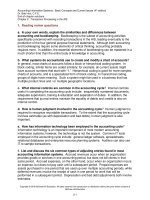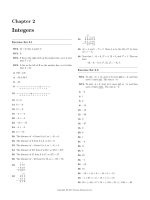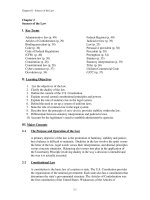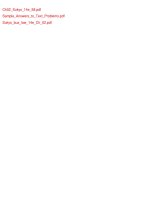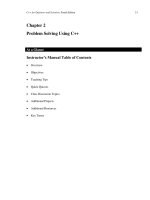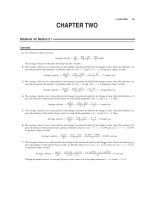Test bank and solution of ch02 basic elements of c++ (1)
Bạn đang xem bản rút gọn của tài liệu. Xem và tải ngay bản đầy đủ của tài liệu tại đây (189.6 KB, 7 trang )
Chapter 2: Basic Elements of C++
TRUE/FALSE
1. In C++, reserved words are the same as predefined identifiers.
ANS: F
PTS: 1
REF: 36
2. The maximum number of significant digits in values of the double type is 15.
ANS: T
PTS: 1
REF: 42
3. The maximum number of significant digits in float values is up to 6 or 7.
ANS: T
PTS: 1
REF: 42
4. An operator that has only one operand is called a unique operator.
ANS: F
PTS: 1
REF: 45
5. If a C++ arithmetic expression has no parentheses, operators are evaluated from left to right.
ANS: T
PTS: 1
REF: 46
6. A mixed arithmetic expression contains all operands of the same type.
ANS: F
PTS: 1
REF: 49
7. Suppose a = 5. After the execution of the statement ++a; the value of a is 6.
ANS: T
PTS: 1
REF: 70
8. The escape sequence \r moves the insertion point to the beginning of the next line.
ANS: F
PTS: 1
REF: 78
9. A comma is also called a statement terminator.
ANS: F
PTS: 1
REF: 90
10. Suppose that sum is an int variable. The statement sum += 7; is equivalent to the statement sum
= sum + 7;
ANS: T
PTS: 1
REF: 95
MULTIPLE CHOICE
1. The ____ rules of a programming language tell you which statements are legal, or accepted by the
programming language.
a. semantic
c. syntax
b. logical
d. grammatical
ANS: C
PTS: 1
REF: 34
2. Which of the following is a reserved word in C++?
a. char
c. CHAR
b. Char
d. character
ANS: A
PTS: 1
3. Which of the following is a legal identifier?
a. program!
b. program_1
ANS: B
PTS: 1
4. ____ is a valid int value.
a. 46,259
b. 46259
ANS: B
PTS: 1
5. ____ is a valid char value.
a. -129
b. ‘A’
ANS: B
PTS: 1
REF: 36
c. 1program
d. program 1
REF: 36
c. 462.59
d. -32.00
REF: 39-40
c. 128
d. 129
REF: 40
6. An example of a floating point data type is ____.
a. int
c. double
b. char
d. short
ANS: C
PTS: 1
REF: 41
7. The memory allocated for a float value is ____ bytes.
a. two
c. eight
b. four
d. sixteen
ANS: B
PTS: 1
REF: 42
8. The value of the expression 33/10, assuming both values are integral data types, is ____.
a. 0.3
c. 3.0
b. 3
d. 3.3
ANS: B
PTS: 1
REF: 43-44
9. The value of the expression 17 % 7 is ____.
a. 1
c. 3
b. 2
d. 4
ANS: C
PTS: 1
REF: 43-44
10. The expression static_cast<int>(9.9) evaluates to ____.
a. 9
c. 9.9
b. 10
d. 9.0
ANS: A
PTS: 1
REF: 51
11. The expression static_cast<int>(6.9) + static_cast<int>(7.9) evaluates to ____.
a. 13
c. 14.8
14
b.
d. 15
ANS: A
PTS: 1
REF: 51
12. The length of the string "computer science" is ____.
a. 14
c. 16
b. 15
d. 18
ANS: C
PTS: 1
REF: 54
13. In a C++ program, one and two are double variables and input values are 10.5 and 30.6.
After the statement cin >> one >> two; executes, ____.
a. one = 10.5, two = 10.5
c. one = 30.6, two = 30.6
b. one = 10.5, two = 30.6
d. one = 11, two = 31
ANS: B
PTS: 1
REF: 64
14. Suppose that count is an int variable and count = 1. After the statement count++; executes,
the value of count is ____.
a. 1
c. 3
2
b.
d. 4
ANS: B
PTS: 1
REF: 70
15. Suppose that alpha and beta are int variables. The statement alpha = --beta; is equivalent to
the statement(s) ____.
a. alpha = 1 - beta;
b. alpha = beta - 1;
c. beta = beta - 1;
alpha = beta;
d. alpha = beta;
beta = beta - 1;
ANS: C
PTS: 1
REF: 70-71
16. Suppose that alpha and beta are int variables. The statement alpha = beta--; is equivalent to
the statement(s) ____.
a. alpha = 1 - beta;
b. alpha = beta - 1;
c. beta = beta - 1;
alpha = beta;
d. alpha = beta;
beta = beta - 1;
ANS: D
PTS: 1
REF: 70-71
17. Suppose that alpha and beta are int variables. The statement alpha = beta++; is equivalent to
the statement(s) ____.
a. alpha = 1 + beta;
b. alpha = alpha + beta;
c. alpha = beta;
beta = beta + 1;
d. beta = beta + 1;
alpha = beta;
ANS: C
PTS: 1
REF: 70-71
18. Suppose that alpha and beta are int variables. The statement alpha = ++beta; is equivalent to
the statement(s) ____.
a. beta = beta + 1;
alpha = beta;
b. alpha = beta;
beta = beta + 1;
c. alpha = alpha + beta;
d. alpha = beta + 1;
ANS: A
PTS: 1
REF: 70-71
19. Choose the output of the following C++ statement:
cout << "Sunny " << '\n' << "Day " << endl;
a. Sunny \nDay
b. Sunny \nDay endl
c. Sunny
Day
d. Sunny \n
Day
ANS: C
PTS: 1
REF: 73
20. Which of the following is the newline character?
a. \r
c. \l
b. \n
d. \b
ANS: B
PTS: 1
REF: 73
21. Consider the following code.
// Insertion Point 1
using namespace std;
const float PI = 3.14;
int main()
{
//Insertion Point 2
float r = 2.0;
float area;
area = PI * r * r;
cout << "Area = " << area <
}
// Insertion Point 3
In this code, where does the include statement belong?
a. Insertion Point 1
c. Insertion Point 3
b. Insertion Point 2
d. Anywhere in the program
ANS: A
PTS: 1
REF: 80
22. ____ are executable statements that inform the user what to do.
a. Variables
c. Named constants
b. Prompt lines
d. Expressions
ANS: B
PTS: 1
REF: 91
23. The declaration int a, b, c; is equivalent to which of the following?
a. inta , b, c;
c. int abc;
b. int a,b,c;
d. int a b c;
ANS: B
PTS: 1
REF: 92
24. Suppose that alpha and beta are int variables and alpha = 5 and beta = 10. After the
statement alpha *= beta; executes, ____.
a. alpha = 5
c. alpha = 50
b. alpha = 10
d. alpha = 50.0
ANS: C
PTS: 1
REF: 94
25. Suppose that sum and num are int variables and sum = 5 and num = 10. After the statement
sum += num executes, ____.
a. sum = 0
c. sum = 10
b. sum = 5
d. sum = 15
ANS: D
PTS: 1
REF: 95
COMPLETION
1. ____________________ is the process of planning and creating a program.
ANS:
Programming
programming
PTS: 1
REF: 28
2. A(n) ____________________ is a memory location whose contents can be changed.
ANS: variable
PTS: 1
REF: 33
3. A(n) ____________________ is a collection of statements, and when it is activated, or executed, it
accomplishes something.
ANS:
subprogram
sub program
sub-program
function
modlue
PTS: 1
REF: 34
4. ____________________ functions are those that have already been written and are provided as part of
the system.
ANS:
Predefined
predefined
Standard
standard
PTS: 1
REF: 34
5. ____________________ rules determine the meaning of instructions.
ANS:
Semantic
semantic
PTS: 1
REF: 34
6. ____________________ can be used to identify the authors of the program, give the date when the
program is written or modified, give a brief explanation of the program, and explain the meaning of
key statements in a program.
ANS:
Comments
comments
PTS: 1
REF: 34
7. The smallest individual unit of a program written in any language is called a(n)
____________________.
ANS: token
PTS: 1
REF: 35
8. In a C++ program, ____________________ are used to separate special symbols, reserved words, and
identifiers.
ANS:
whitespaces
whitespace
white spaces
white space
PTS: 1
REF: 37
9. The ____________________ type is C++ ’s method for allowing programmers to create their own
simple data types.
ANS: enumeration
PTS: 1
REF: 38
10. The memory space for a(n) ____________________ data value is 64 bytes.
ANS: long long
PTS: 1
REF: 39
11. The maximum number of significant digits is called the ____________________.
ANS: precision
PTS: 1
REF: 42
12. When a value of one data type is automatically changed to another data type, a(n)
____________________ type coercion is said to have occurred.
ANS: implicit
PTS: 1
REF: 51
13. A(n) ____________________ is a sequence of zero or more characters.
ANS: string
PTS: 1
REF: 53
14. In C++, you can use a(n) ____________________ to instruct a program to mark those memory
locations in which data is fixed throughout program execution.
ANS:
named constant
constant
PTS: 1
REF: 55
15. A data type is called ____________________ if the variable or named constant of that type can store
only one value at a time.
ANS:
simple
PTS: 1
REF: 57
